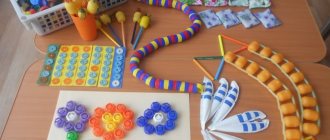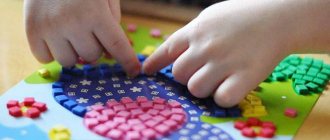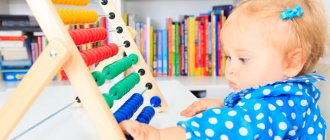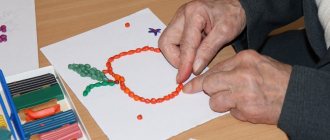Greetings, my beloved readers! Every parent knows that the more our children move, the better they develop. And you can move in different ways. Thus, scientists have proven that active movements of the fingers are directly related to the level of development of the so-called “speech” zones in children.
And they, these movements, have a good effect on the cerebral cortex. So, exercises for the development of fine motor skills are a way to stimulate mental development and a real assistant in mastering the art of public speaking.
If previously most of the housework was done by our mothers and children by hand - they washed the floors, washed and wrung out clothes, knitted and embroidered, sorted out cereals, now our children come to do everything ready-made.
Two-thirds, or even more, of household work that requires the participation of fingers is done for us by equipment - combines, vacuum cleaners, washing machines. We have almost forgotten how to knit and sew, and we cook porridge from bags where everything has already been sorted out. So let's start training our speech and mind today. I propose to learn a number of simple exercises for younger schoolchildren.
Rolling
You can roll anything you like in your hands: balls, walnuts, hex pencils, and even mom’s curlers. The most suitable material for the hands will be the one that pricks like a hedgehog, since the “needles” will further increase the sharpness of tactile sensations and disperse the blood. So, let's do self-massage.
Roll the pencil along the table, sandwiched between your palm and the work surface. We roll it, passing it between our fingers like an equilibrist, holding it in a certain position. We actively rub it, sandwiched between two palms.
And now it’s the ball’s turn.
Rolling the ball along a given path perfectly develops coordination along with motor skills. You can draw a path in the form of a labyrinth or a spiral along which a ball held between your palm and the surface of the paper will run towards a given goal.
Great! Do you have two walnuts lying around the house that have not yet been eaten? You can use them too!
We hold two nuts in one hand and begin to roll them, as if we were trying to polish their uneven edges.
Lacing and mosaic
Whose preschooler can boast that he ties his own shoelaces? But the sooner he learns this, the better.
Lacing is one of the effective ways to develop fine motor skills. Unwinding, untying, stringing - all this is good for preschoolers. And for older children there are special tasks when you need to lace according to an algorithm - a pattern, or connect the missing parts in the image using a lace.
And in general, for our fashionable children you can find examples of unusual, beautiful lacing on shoes - let them practice if they want to be in trend!
Mosaic is similar to lacing, which, just like the skill of stringing small beads on a thread, requires the ability to hold small parts in your fingers that need to be folded into a pattern. Everything can be used here: from buttons and beads to pasta and peas. The main thing is to use your imagination, and you will get a real work of art!
Modeling
Plasticine, salt dough, clay are excellent helpers in the development of fine motor skills in preschoolers and elementary school students. There is not only speech and mental training here, there is also the “unwinding” of imagination and the creative component.
For preschool children, this is a real lesson that instills accuracy, perseverance and hard work. So, we roll out “sausages”, roll balls, and make three-dimensional shapes from all this.
Do you want to combine business with pleasure? Then make pies with the kids from dough: pretzel buns, puff pastry or yeast dough - it doesn’t matter. The main thing is to knead, sculpt, roll out with your hands. It’s delicious for lunch and a workout for the brain.
Finger gymnastics in lessons for the development of fine motor skills in schoolchildren
Zhirnova Elizaveta
Finger gymnastics in lessons for the development of fine motor skills in schoolchildren
Finger gymnastics in lessons.
When accepting children into the first grade, not only the teacher is faced with the fact that first-graders cannot hold a pen correctly, but the students also face difficulties in mastering their first writing skills. But writing is a rather complex skill for a student, based on subtle hand movements. Only coordinated work of the small muscles of the hand , developed visual perception and voluntary attention will contribute to success in mastering the technique of writing. Why does a child hold a pen incorrectly? The reason is insufficient development of the hands . In this case, you need to turn to finger gymnastics , since simple exercises will help ensure the necessary preparation of the child’s hand for writing.
Fine motor skills are the ability to make small and precise movements with the hands ( fingers , hands)
.
The sphere of fine motor skills consists of a considerable number of different hand movements - from simple (holding something, grabbing something)
to complex
(writing techniques, drawing, drawing)
.
The formation of fine motor skills is closely related to the formation of the child’s mental cognitive processes (memory, sensation, perception, imagination, thinking, as well as the development of speech . Science has proven that the speech and motor centers of the brain are located nearby - that’s why stimulation of the nerve endings that are located on fingertips , contribute to the activation of speech development . Thanks to the development of fine motor skills , children develop manual dexterity, beautiful handwriting, and quick reactions. If fine motor skills are well developed, it means that the student is fine with memory, logic and thinking.
Starting from the first days of working with first-graders, I pay great attention to the formation of fine motor skills . In every lesson, when doing a written activity - either at the beginning, or in the middle or at the end - we massage our fingers . Students and I carefully massage the fingers of each hand , starting from the tips. We do this with stroking, rubbing, circular movements. Here are a few of the exercises we do with our children.
1. "Clap"
- We clap our hands loudly and loudly.
2. "Flower"
- palms facing each other and closed. The palms then open, forming a flower, then close again.
3. Both palms are on the table. Simultaneously with the pronunciation of the tongue twister, the right hand slides along the table and outlines a circle, and the left hand slides up and down.
4. Hands lie on the table, as if on the keys:
- hitting the table with the thumbs of both hands ;
- hitting the table with the index fingers of both hands , etc. d.
5. Palms lie tightly on the table. Starting with the little finger, we raise one finger on the right hand , then on the left hand, then on both hands at the same time.
6. Both palms are on the table. One palm moves up and down, the second moves left and right.
To diversify the finger , we perform it not only with our hands, but also use various objects (for example, pencils, pens, crumpled paper)
.
This variety also contributes to the development of intelligence .
1. Roll a pen or pencil between your palms.
2. Use the blunt end of a pen or pencil to massage the pad of each finger .
3. "Preparing the dough"
- place one palm on the desk and roll a pen or pencil over it.
Children also enjoy performing verbal finger exercises :
1,2,3,4.5 (claps)
The finger went out (the index finger makes a circular motion in the center of the left hand)
Just left the gate -
Lo and behold, another one is coming towards him (the middle finger joins)
It's fun to go together
Come on, the third one comes out (nameless joins)
Let's dance together -
Here. (clap and hands change places)
2. The fingers of both hands are folded together.
- Who arrived? (clap thumbs )
We, we, we! (the big ones are pressed, the rest are clapping)
-Mom, mom, is that you? (clap thumbs )
Yes Yes Yes! (clap index fingers )
Dad, dad, is that you? (clap thumbs )
Yes Yes Yes! (clap middle fingers )
- Brother, brother, is that you? (clap thumbs )
Yes Yes Yes! (clap ring fingers )
- Oh, little sister, is that you? (clap thumbs )
Yes Yes Yes! (clap our little fingers )
We are all together! Yes Yes Yes! (all fingers )
Indeed, regular repetition of such exercises has a beneficial effect on speech, increases the mobility and flexibility of the hands, and improves blood circulation. Thanks to finger exercises, children also develop their creative abilities. If you put in more effort at the beginning, you can get a good result in the end.
Paper
Anything that can be cut, painted, or folded into appliques – all this is suitable for motor skills training.
Of course, origami is more valuable among paper creations. It requires both hands, so both the left and right hemispheres develop simultaneously. And what skill and ingenuity is needed to fold a simple sheet of paper into a figure. And when paper masterpieces are made from small triangles, what patience and perseverance is required!
Among exercises with paper and pencils, teachers highly recommend shading, because it helps preschool children prepare for writing, and gives younger schoolchildren the opportunity to hone their skills by learning to draw lines without interruption. Teaches you how to hatch and draw freely with a sense of correct inclination, which is important for handwriting.
Well, I won’t even talk about the load on the small muscles of the hands and fingers - you know about that yourself. Well, or try shading something - feel it from your own experience.
It is also useful to cut, since wielding scissors also requires effort and is directly related to the development of motor skills. In a straight line, diagonally, circles and squares, ovals and rectangles - all these skills can be found in making... snowflakes. Yes, yes, snowflakes with a lot of elaborate lines. That's where you'll have to puff!
Periods of child development in preschool age
The famous Italian teacher Maria Montessori identified three periods of children's development:
• development of children's speech (from 0 to 6 years). At this time, two important events occur. From 1 year to 2.5 years, a child’s vocabulary quickly expands. At 4-4.5 years old, he masters writing (but only if fine motor skills are developed);
• perception of small objects (from 1.5 to 5.5 years). At this age, the child loves to play with buttons, beads, sticks, etc. With the help of such objects, you can develop the motor skills of the child’s hands. Just be sure to make sure your baby doesn’t put them in his mouth;
• formation of simple self-service skills (from 1 year to 4 years). At this age, the child is taught to dress, eat and perform hygiene procedures independently.
Motor skills are of 3 types:
- large;
- small;
- certain organs.
Gross motor skills include rolling over, walking, bending, crawling, jumping, running, and the like. Gross motor development typically occurs from top to bottom. First, the child learns to control eye movements, then arms and legs.
Gross motor skills are a kind of foundation on which fine motor movements are superimposed with age. They are more subtle and complex.
Fine motor skills are very important for a child's development. The nerve endings located on the tips of the baby's fingers help transmit many signals to the brain center, so the influence of fine motor skills on the development of the child as a whole is obvious.
Fine motor skills are the performance of precise small movements using the fingers and hands. Typically, a child who has a high level of fine motor development is intellectually ready for school. He reasons logically quite well, he has developed attention and memory, and coherent speech.
But, unfortunately, 70-80% of first-graders have an unsatisfactory level of fine motor skills. This leads to underdeveloped hands; it is difficult for a young student to withstand prolonged hand tension while writing, and prevents the child from developing good handwriting. The student cannot draw sufficiently straight and clear lines; it is difficult to write numbers and letters; it is not easy for the child to cut out shapes from paper and along the contour, etc.
The development of fine motor skills is closely related to the development of speech. The child cannot clearly express his thoughts or explain his point of view. All of these factors show how important fine motor skills are for students.
The development of motor skills in schoolchildren is the most important task of teachers. Gross motor skills will help the student be more dexterous and relieve various problems associated with growth. At school age, scoliosis (curvature of the spine) and stooping are quite common. Special exercises will help strengthen bone tissue and help your child grow up healthy. To do this, you need to attend physical education classes. While younger schoolchildren attend them with pleasure, in middle, and even more so in high school, some students try to avoid classes. It is important for the teacher to understand the reason. Perhaps the child is not interested and should think about how to raise the prestige of physical education classes. Sports competitions and clubs contribute to the development of gross motor skills. At school age, it is advisable, in addition to physical education, to engage in additional sports training. This could be swimming, basketball, football, etc. Dancing also perfectly develops general motor skills.
To develop fine motor skills in schoolchildren more effectively, we can recommend the following:
Construction;
Drawing;
Exercises with mosaics;
Cutting out various shapes with scissors;
Translating pictures by tracing an outline through carbon paper;
For boys - working with tools;
For girls - embroidery, knitting;
Sorting out peas and cereals for cooking during home economics lessons;
Playing the piano, accordion, guitar, etc.;
Modeling from plasticine, clay;
Turning pages of books;
A child can develop fine motor skills not only at school by attending clubs, but also at home. There are very, very many types of such activities. Parents should involve their child in activities that are interesting and accessible to him. For example, my mother and grandmother started baking pies. The child will be happy to help replace the dough and carefully sculpt the pies.
In the summer, you can work together with your children to weed the garden, collect garden and forest berries, and then sort them. Older children will be able to peel and cut boiled vegetables (not with a sharp knife). Thanks to all these interesting, systematically performed exercises, the child’s hands will gain precision, strength and coordination of movements.
Now we can dwell in a little more detail on some of the means of successful development of motor skills:
Various educational toys help develop fingers. In addition to improving motor skills, they will awaken in the child a desire to experiment, think logically in order to perform constructive actions. Memory and imagination are also trained. After all, a schoolchild must remember the actions that adults showed him.
"Creation". Modeling, drawing, designing, applique - practicing these types of activities will help not only improve fine motor skills, but also develop attention, perception, imagination, and develop a sense of color.
"Games with balls." Several types of balls can be used. They can be different in size, color, material, texture.
A variety of sets of small balls will allow you to use those that will help you complete the teacher’s tasks, based on the age and physical characteristics of the child.
As you can see, the development of motor skills helps improve the child’s speech, memory, attention, and imagination. During non-school time, parents themselves can find many exciting activities for their child to develop his motor skills.
Recommendations for parents
1. Exercises to develop fine motor skills are carried out in a complex, starting from the first months of a child’s life.
2. In the set of exercises, try to include tasks for squeezing, relaxing and stretching the baby’s hands.
3. Start or end your sessions with a hand massage session.
4. Carry out work on developing fine motor skills regularly, in accordance with the age and taking into account the level of physical development of the baby.
5. At first, the adult performs all movements with the baby’s hands, and as the child masters it, he begins to do them independently.
6. Carefully ensure that the child performs the exercises correctly. If your child finds it difficult to complete any task, immediately help him: fix the desired position of his fingers, etc.
7. Alternate between new and old games and exercises. After your child has mastered simple motor skills, move on to mastering more complex ones.
8. Perform certain movements simultaneously with listening (and then with the child pronouncing) the poem.
9. Encourage your child’s creative activity, let him come up with some exercises himself.
10. Conduct classes emotionally, actively, praise your child for his successes, but do not forget to monitor his mood and physical condition.
Exercises to develop fine motor skills for children over 2 years old
1. "Fisherman"
Pour water into a bowl and throw in several small objects: pieces of cork, twigs, large beads, etc. Invite your baby, using a small sieve tied to a stick, to catch all these objects in turn and put them on a plate on the tray on the right from the bowl. The baby should hold the “fishing rod” with one hand.
2. "Path"
Make a path 3-5 cm wide on the table, bounded on both sides by strips of paper. Invite your child to sprinkle it with semolina or millet. You need to pick up the cereal with three fingers and try not to spill it over the edges of the path.
3. “Magic Spoon”
Place two cups on the tray: on the left is a cup with cereal, and on the right is empty. Moving your child's hand, show him how to take the cereal with a spoon. Carefully bring the spoon to the empty cup and tip it over it. Task: pour all the cereal from the left cup to the right one.
4. “Sweet tea”
Your baby can already add sugar to his tea on his own. Now teach him to stir sugar in a mug.
5. "Salute"
The child takes small pieces of colored paper and tries to tear them as small as possible. He places the torn pieces on a saucer. Then you need to take all the pieces in your palms and throw them up.
6. “Make a lump”
Give your child a piece of paper. His task: to crumple the leaf so as to form a dense lump.
7. "Spyglass"
The child takes a sheet of A4 paper and rolls it into a tube with both hands, after which he brings the tube to his eye and examines surrounding objects through it.
8. “Collect the sticks”
Scatter the counting sticks in front of the child. The kid must collect them all one by one back into the box.
Outlines
Invite the child to circle the one of the two representatives of the same natural group (birds, animals, fish, insects) about whom the riddle was written. You need to carefully draw all the contour lines, without “confusing” them, without going beyond the boundaries of the images.
Additional tasks for each page will help to captivate the child in the process, create motivation for work, and they are also another stage in training dexterity, attention, and intelligence.
Tasks by points
Ask the preschooler to draw one of the simple figures presented (animal, bird, flower) using reference points, following the model. Tasks of this type train not only fine motor skills, but also counting skills, the ability to navigate on a sheet of paper, and coordination of movements.
Conducting tracks
Funny characters are hurrying home! Let your baby help insects, fish, spaceships, and tops move smoothly and beautifully.
Each sheet of this series is designed in such a way that the first two lines need to be drawn inside a given “track”, and the next two - without relying on external borders. It is important to avoid additional obstacles (pebbles, stars, clouds) as carefully as possible!
Modeling for the development of fine motor skills
Modeling is an excellent activity option that stimulates the development of fine motor skills, but not only that. While working with the material, children of primary school age receive the opportunity for both intellectual and aesthetic development.
By sculpting figures and compositions, the child learns:
- develop labor skills;
- strengthen fingers;
- improve manual dexterity.
As the fingers strengthen, the child’s speech also develops. In order for him to progress, modeling tasks must be changed, gradually complicating them by adding new techniques that involve the use of different hand movements.
In the process of working with plasticine, children practice various techniques, rolling, pinching, and flattening the material. All these actions help strengthen the hands and allow the fingers and hands to become more sensitive.
Regular modeling classes allow your child to:
- have fun in your free time;
- learn to distinguish colors and shapes;
- develop imagination and fantasy;
- master hand interaction;
- bring your ideas to life.
You can sculpt with children of primary school age not only from plasticine, but also from clay, as well as from salt dough. Crafts made from dough can be baked in the oven, painted with a brush or with your fingers and kept as a keepsake.
About the benefits of the application
Applique is a type of fine art technique that involves cutting out figures and elements and gluing them onto a base with a background. Elements can be made not only from paper, but also from leather, fabric, wool and even natural material.
In the process of working on applications, children learn to develop coordination of movements, wield scissors, develop spatial thinking, and study shapes and colors. In addition, applique, like modeling, stimulates the development of fine motor skills of the hands.
Mosaic for motor skills development
Children of primary school age enjoy working with colored mosaics at home and in craft lessons, putting together patterns according to the pattern. Such activities stimulate the development of fine motor skills and speech skills, teach children to finish what they start, to be attentive and concentrated.
As the younger student progresses in the process of assembling a mosaic, you can complicate his tasks by asking him to work with smaller parts, assemble patterns without a sample, or come up with patterns on his own.
Lacing and mosaic
Whose preschooler can boast that he ties his own shoelaces? But the sooner he learns this, the better.
Lacing is one of the effective ways to develop fine motor skills. Unwinding, untying, stringing - all this is good for preschoolers. And for older children there are special tasks when you need to lace according to an algorithm - a pattern, or connect the missing parts in the image using a lace.
And in general, for our fashionable children you can find examples of unusual, beautiful lacing on shoes - let them practice if they want to be in trend!
Mosaic is similar to lacing, which, just like the skill of stringing small beads on a thread, requires the ability to hold small parts in your fingers that need to be folded into a pattern. Everything can be used here: from buttons and beads to pasta and peas. The main thing is to use your imagination, and you will get a real work of art!
Paper
Anything that can be cut, painted, or folded into appliques – all this is suitable for motor skills training.
Of course, origami is more valuable among paper creations. It requires both hands, so both the left and right hemispheres develop simultaneously. And what skill and ingenuity is needed to fold a simple sheet of paper into a figure. And when paper masterpieces are made from small triangles, what patience and perseverance is required!
Among exercises with paper and pencils, teachers highly recommend shading, because it helps preschool children prepare for writing, and gives younger schoolchildren the opportunity to hone their skills by learning to draw lines without interruption. Teaches you how to hatch and draw freely with a sense of correct inclination, which is important for handwriting.
Well, I won’t even talk about the load on the small muscles of the hands and fingers - you know about that yourself. Well, or try shading something - feel it from your own experience.
It is also useful to cut, since wielding scissors also requires effort and is directly related to the development of motor skills. In a straight line, diagonally, circles and squares, ovals and rectangles - all these skills can be found in making... snowflakes. Yes, yes, snowflakes with a lot of elaborate lines. That's where you'll have to puff!
Games with buttons
Invite the children to make a pattern or an image of some object from different buttons; this is more interesting to do for a while. It is best to take small buttons, and make the base for the picture from thick cardboard, covered with a layer of plasticine on top (this will help securely fix all the details of the “mosaic”).
Working with plasticine
Here you will need several copies of the drawings given in this section. This will allow your baby to acquire the skill of carefully working with plasticine. His best works can be used as an exhibition.
You will need plasticine of different colors.
1. "Snowman"
Invite your child to decorate a snowman using plasticine. Let the baby work hard and smear the plasticine with his fingers, without going beyond the boundaries of the outline of the drawing.
2. “Seven-flowered flower”
The child must choose seven colors of plasticine - for each petal of a seven-flowered flower. Make sure that it does not go beyond the boundaries of its contour. If something doesn’t work out for a child, help him.
We trace along the contour
These exercises are aimed at teaching the child to make smooth lines without lifting the pencil from the paper. Invite your child to trace the outline of the drawings. Let him say what is depicted on them. After this, you can ask your child to color these drawings.
1. “Mushroom”
2. "Bunny"
3. "Hedgehog"
4. "Butterfly"
5. “Herringbone”
6. “Autumn leaf”








